warning light MAZDA MODEL 2 2011 Owner's Manual
[x] Cancel search | Manufacturer: MAZDA, Model Year: 2011, Model line: MODEL 2, Model: MAZDA MODEL 2 2011Pages: 340, PDF Size: 3.88 MB
Page 82 of 340

Black plate (82,1)
qLuggage Compartment
WARNING
Do not place anything on top of the
cover:
Placing luggage or other cargo on
top of the luggage compartment
cover is dangerous. During sudden
braking or a collision, the cargo
could become a projectile that could
hit and injure someone. The vehicle
has a light weight luggage
compartment cover to keep the
contents of your luggage area out of
sight; it will not retain heavy objects
that are not tied down in an accident
such as a rollover. Tie down all heavy
objects, whether luggage or cargo,
using the tie down hooks.
Make sure luggage and cargo is
secured before driving: Not securing cargo while driving is
dangerous as it could move or be
crushed during sudden braking or a
collision and cause injury.
CAUTION
ØMake sure the luggage
compartment cover is firmly
secured. If it is not firmly secured,
it could unexpectedly disengage
resulting in injury.
Ø Do not place heavy objects or
apply excessive force to the top of
the luggage compartment cover
(Maximum weight: 2 kg).
Overloading could cause
deformation or damage to the
luggage compartment cover. Also,
the liftgate could drop
unexpectedly if it is opened with
heavy objects on the luggage
compartment cover, resulting in
injury.
Luggage compartment cover strap
The luggage compartment can be
accessed by opening the liftgate when the
straps are attached to the sides of the
liftgate.
StrapHook
3-14
Knowing Your Mazda
Doors and Locks
Mazda2_8BX2-EA-10K_Edition2 Page82
Thursday, December 23 2010 4:47 PM
Form No.8BX2-EA-10K
Page 86 of 340
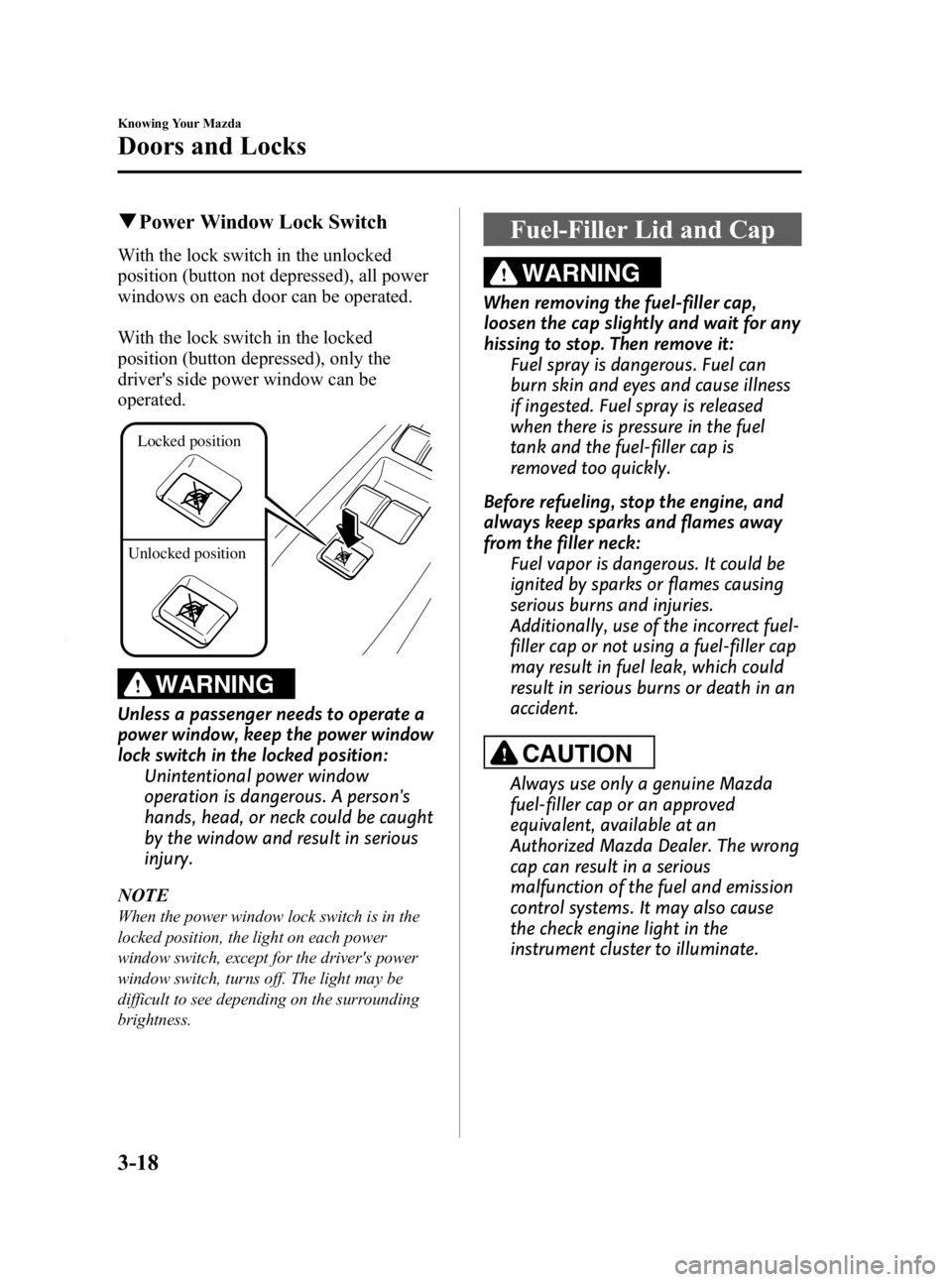
Black plate (86,1)
qPower Window Lock Switch
With the lock switch in the unlocked
position (button not depressed), all power
windows on each door can be operated.
With the lock switch in the locked
position (button depressed), only the
driver's side power window can be
operated.
Locked position
Unlocked position
WARNING
Unless a passenger needs to operate a
power window, keep the power window
lock switch in the locked position: Unintentional power window
operation is dangerous. A person's
hands, head, or neck could be caught
by the window and result in serious
injury.
NOTE
When the power window lock switch is in the
locked position, the light on each power
window switch, except for the driver's power
window switch, turns off. The light may be
difficult to see depending on the surrounding
brightness.
Fuel-Filler Lid and Cap
WARNING
When removing the fuel-filler cap,
loosen the cap slightly and wait for any
hissing to stop. Then remove it: Fuel spray is dangerous. Fuel can
burn skin and eyes and cause illness
if ingested. Fuel spray is released
when there is pressure in the fuel
tank and the fuel-filler cap is
removed too quickly.
Before refueling, stop the engine, and
always keep sparks and flames away
from the filler neck: Fuel vapor is dangerous. It could be
ignited by sparks or flames causing
serious burns and injuries.
Additionally, use of the incorrect fuel-
filler cap or not using a fuel-filler cap
may result in fuel leak, which could
result in serious burns or death in an
accident.
CAUTION
Always use only a genuine Mazda
fuel-filler cap or an approved
equivalent, available at an
Authorized Mazda Dealer. The wrong
cap can result in a serious
malfunction of the fuel and emission
control systems. It may also cause
the check engine light in the
instrument cluster to illuminate.
3-18
Knowing Your Mazda
Doors and Locks
Mazda2_8BX2-EA-10K_Edition2 Page86
Thursday, December 23 2010 4:47 PM
Form No.8BX2-EA-10K
Page 87 of 340
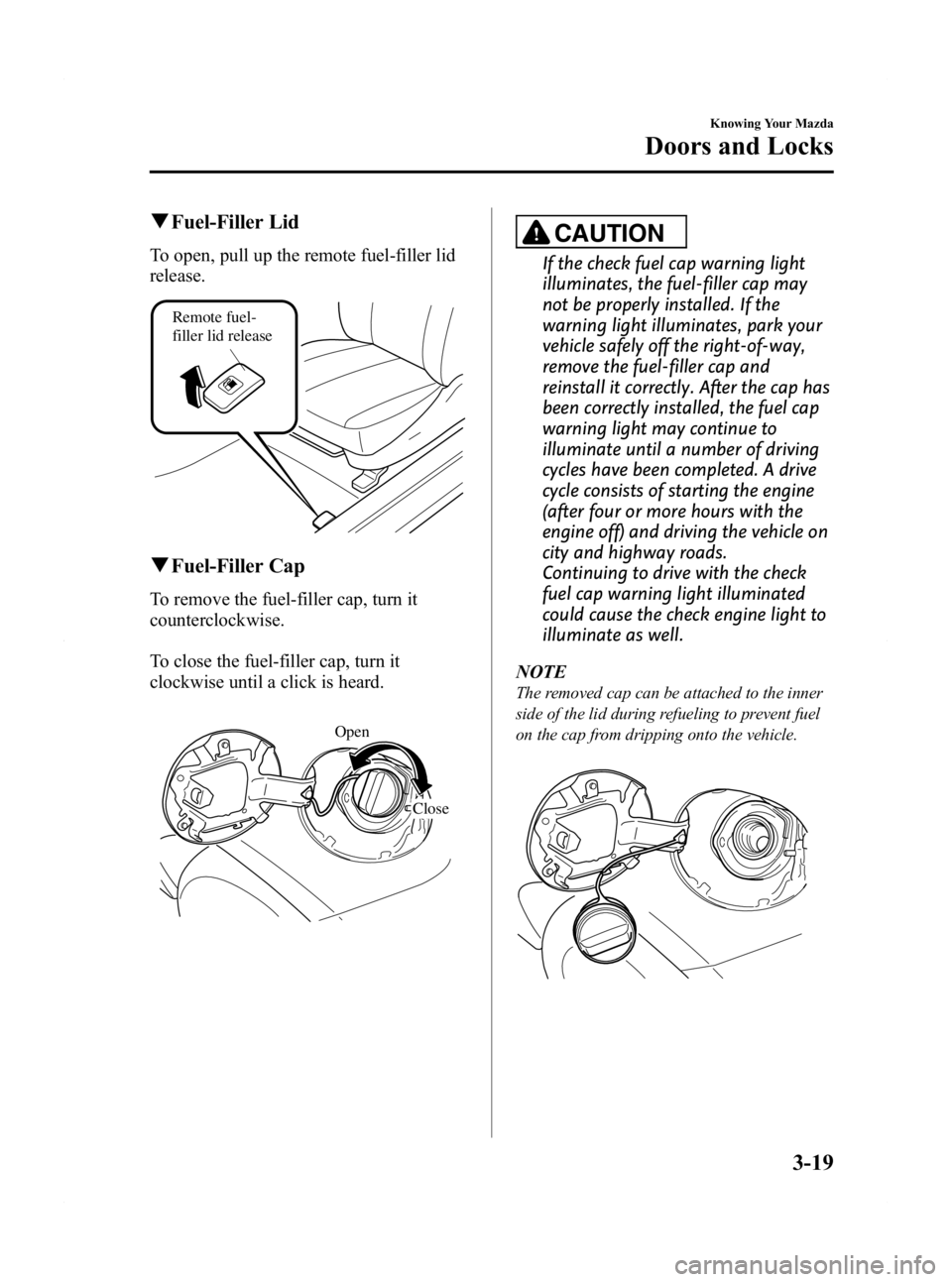
Black plate (87,1)
qFuel-Filler Lid
To open, pull up the remote fuel-filler lid
release.
Remote fuel-
filler lid release
qFuel-Filler Cap
To remove the fuel-filler cap, turn it
counterclockwise.
To close the fuel-filler cap, turn it
clockwise until a click is heard.
Open
Close
CAUTION
If the check fuel cap warning light
illuminates, the fuel-filler cap may
not be properly installed. If the
warning light illuminates, park your
vehicle safely off the right-of-way,
remove the fuel-filler cap and
reinstall it correctly. After the cap has
been correctly installed, the fuel cap
warning light may continue to
illuminate until a number of driving
cycles have been completed. A drive
cycle consists of starting the engine
(after four or more hours with the
engine off) and driving the vehicle on
city and highway roads.
Continuing to drive with the check
fuel cap warning light illuminated
could cause the check engine light to
illuminate as well.
NOTE
The removed cap can be attached to the inner
side of the lid during refueling to prevent fuel
on the cap from dripping onto the vehicle.
Knowing Your Mazda
Doors and Locks
3-19
Mazda2_8BX2-EA-10K_Edition2 Page87
Thursday, December 23 2010 4:47 PM
Form No.8BX2-EA-10K
Page 93 of 340
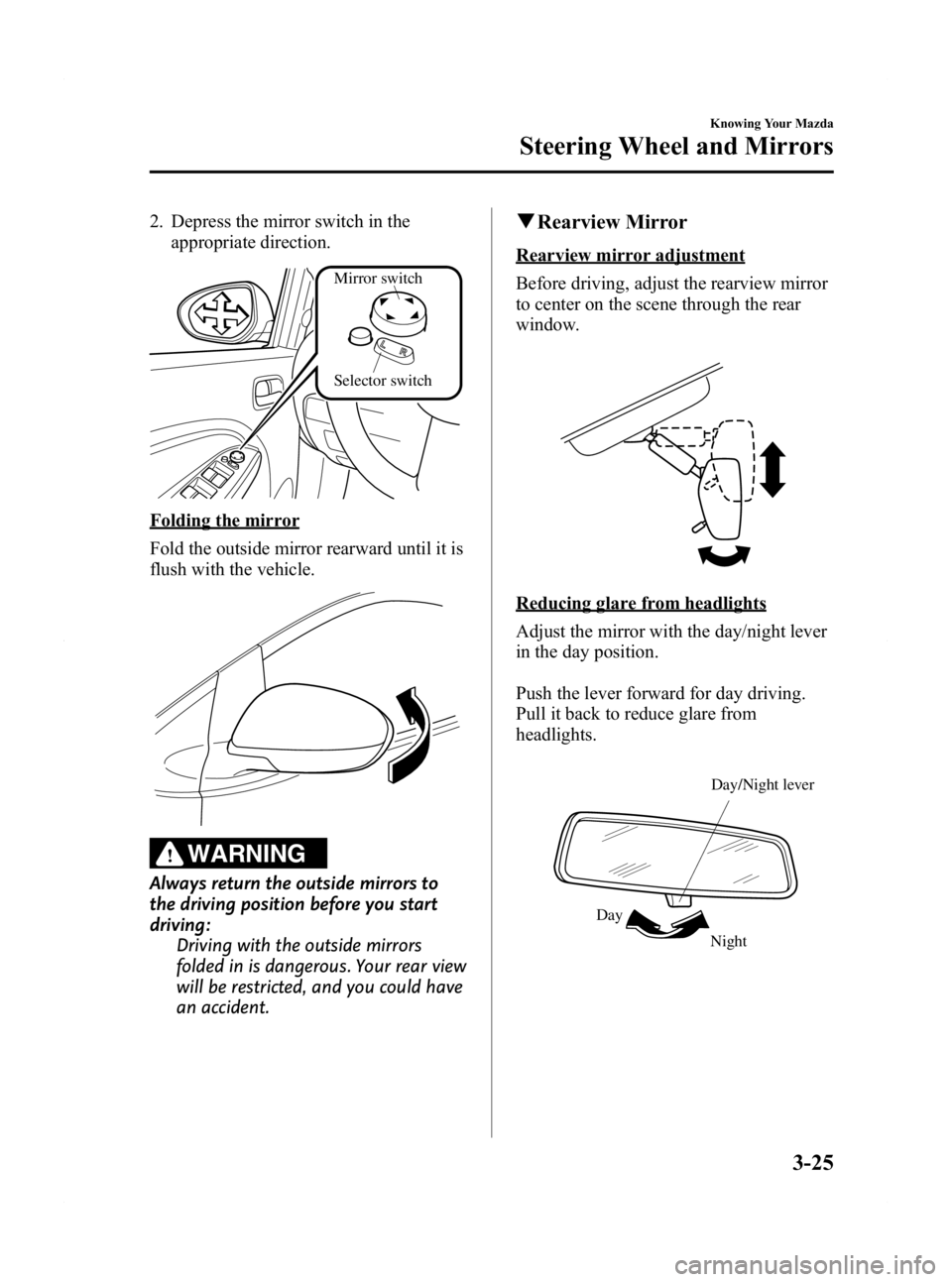
Black plate (93,1)
2. Depress the mirror switch in theappropriate direction.
Selector switchMirror switch
Folding the mirror
Fold the outside mirror rearward until it is
flush with the vehicle.
WARNING
Always return the outside mirrors to
the driving position before you start
driving:
Driving with the outside mirrors
folded in is dangerous. Your rear view
will be restricted, and you could have
an accident.
qRearview Mirror
Rearview mirror adjustment
Before driving, adjust the rearview mirror
to center on the scene through the rear
window.
Reducing glare from headlights
Adjust the mirror with the day/night lever
in the day position.
Push the lever forward for day driving.
Pull it back to reduce glare from
headlights.
Night
Day Day/Night lever
Knowing Your Mazda
Steering Wheel and Mirrors
3-25
Mazda2_8BX2-EA-10K_Edition2 Page93
Thursday, December 23 2010 4:47 PM
Form No.8BX2-EA-10K
Page 99 of 340
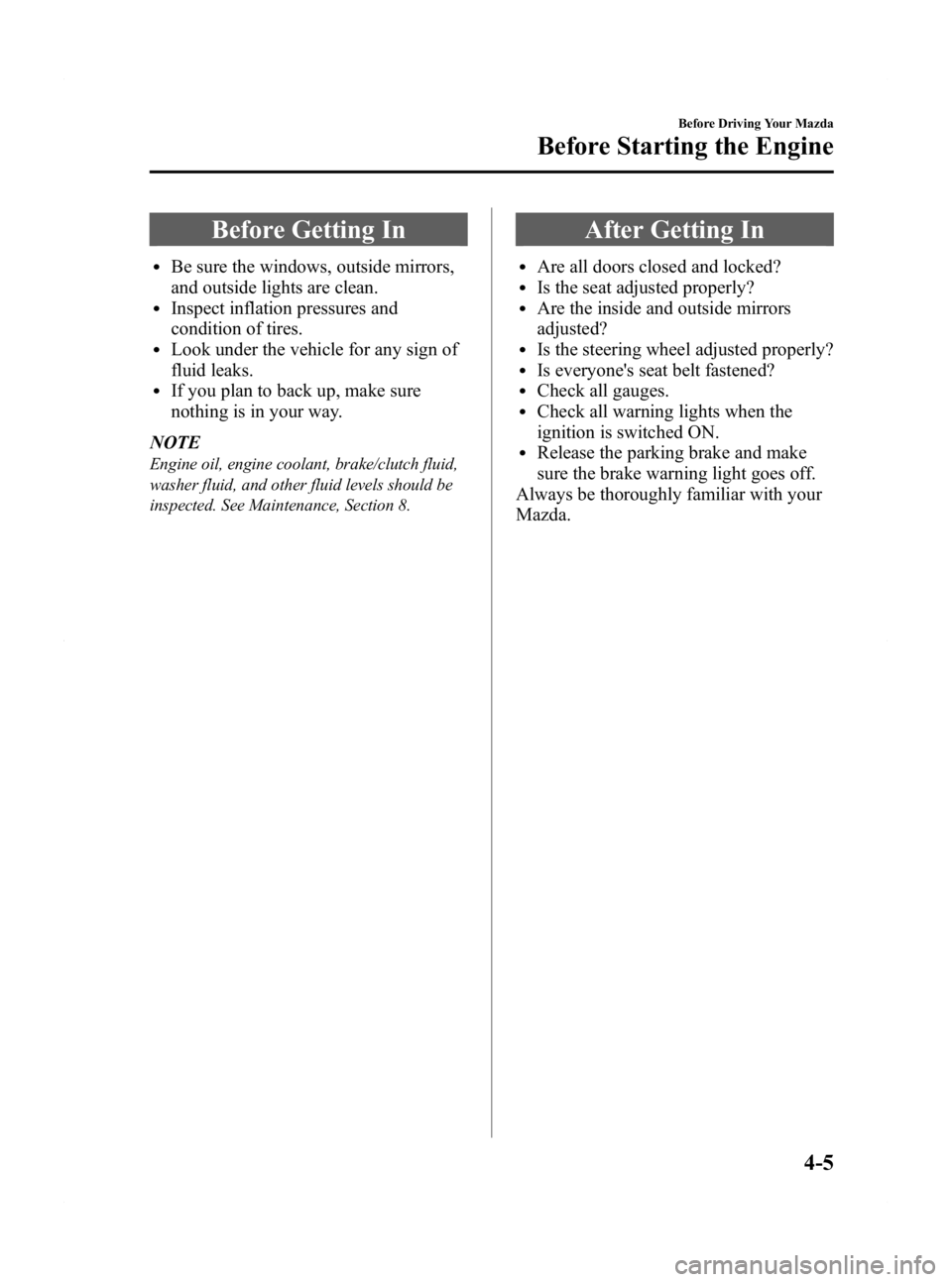
Black plate (99,1)
Before Getting In
lBe sure the windows, outside mirrors,
and outside lights are clean.
lInspect inflation pressures and
condition of tires.
lLook under the vehicle for any sign of
fluid leaks.
lIf you plan to back up, make sure
nothing is in your way.
NOTE
Engine oil, engine coolant, brake/clutch fluid,
washer fluid, and other fluid levels should be
inspected. See Maintenance, Section 8.
After Getting In
lAre all doors closed and locked?lIs the seat adjusted properly?lAre the inside and outside mirrors
adjusted?
lIs the steering wheel adjusted properly?lIs everyone's seat belt fastened?lCheck all gauges.lCheck all warning lights when the
ignition is switched ON.
lRelease the parking brake and make
sure the brake warning light goes off.
Always be thoroughly familiar with your
Mazda.
Before Driving Your Mazda
Before Starting the Engine
4-5
Mazda2_8BX2-EA-10K_Edition2 Page99
Thursday, December 23 2010 4:47 PM
Form No.8BX2-EA-10K
Page 102 of 340
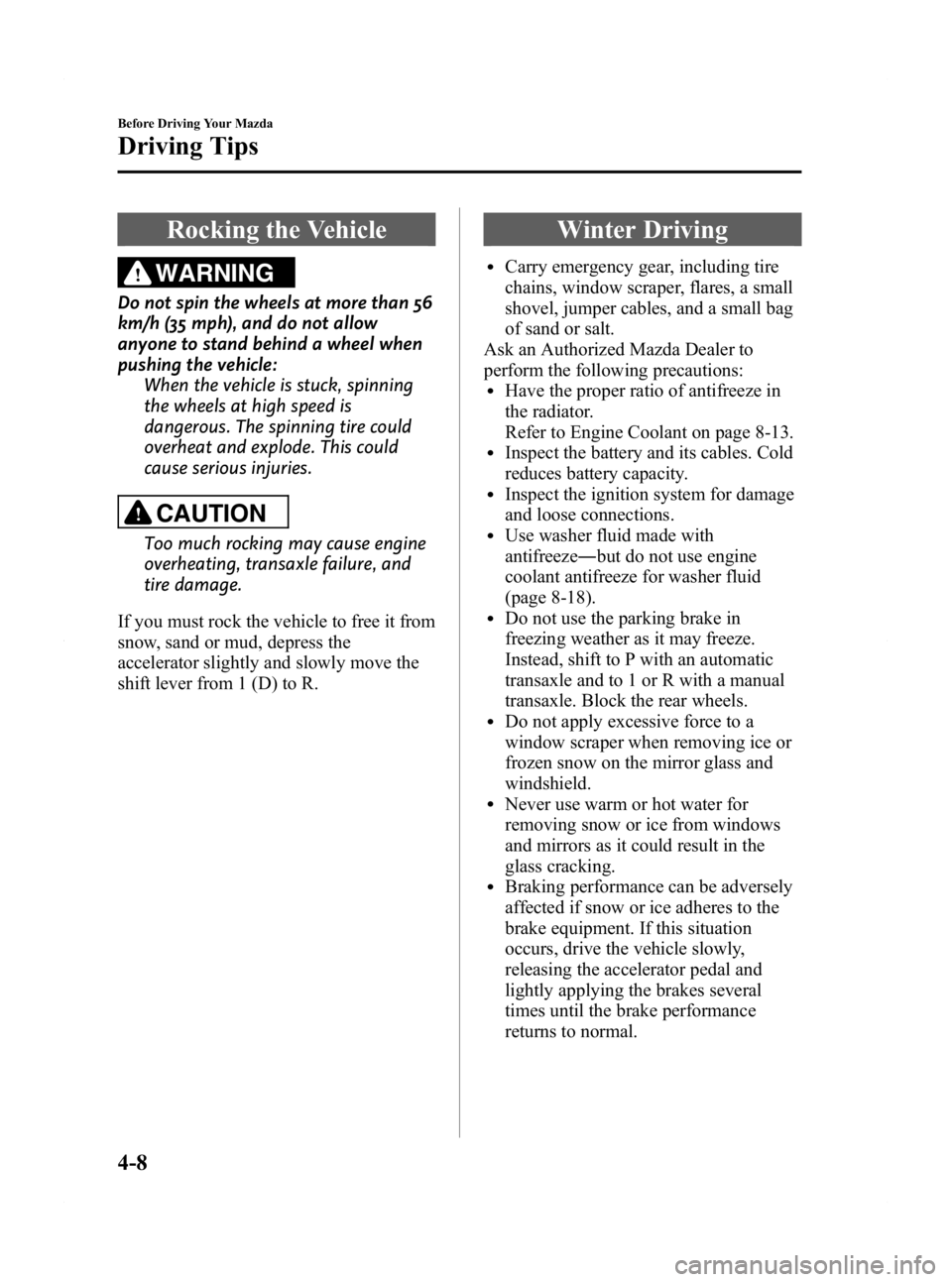
Black plate (102,1)
Rocking the Vehicle
WARNING
Do not spin the wheels at more than 56
km/h (35 mph), and do not allow
anyone to stand behind a wheel when
pushing the vehicle:When the vehicle is stuck, spinning
the wheels at high speed is
dangerous. The spinning tire could
overheat and explode. This could
cause serious injuries.
CAUTION
Too much rocking may cause engine
overheating, transaxle failure, and
tire damage.
If you must rock the vehicle to free it from
snow, sand or mud, depress the
accelerator slightly and slowly move the
shift lever from 1 (D) to R.
Winter Driving
lCarry emergency gear, including tire
chains, window scraper, flares, a small
shovel, jumper cables, and a small bag
of sand or salt.
Ask an Authorized Mazda Dealer to
perform the following precautions:
lHave the proper ratio of antifreeze in
the radiator.
Refer to Engine Coolant on page 8-13.
lInspect the battery and its cables. Cold
reduces battery capacity.
lInspect the ignition system for damage
and loose connections.
lUse washer fluid made with
antifreeze ―but do not use engine
coolant antifreeze for washer fluid
(page 8-18).
lDo not use the parking brake in
freezing weather as it may freeze.
Instead, shift to P with an automatic
transaxle and to 1 or R with a manual
transaxle. Block the rear wheels.
lDo not apply excessive force to a
window scraper when removing ice or
frozen snow on the mirror glass and
windshield.
lNever use warm or hot water for
removing snow or ice from windows
and mirrors as it could result in the
glass cracking.
lBraking performance can be adversely
affected if snow or ice adheres to the
brake equipment. If this situation
occurs, drive the vehicle slowly,
releasing the accelerator pedal and
lightly applying the brakes several
times until the brake performance
returns to normal.
4-8
Before Driving Your Mazda
Driving Tips
Mazda2_8BX2-EA-10K_Edition2 Page102
Thursday, December 23 2010 4:48 PM
Form No.8BX2-EA-10K
Page 104 of 340

Black plate (104,1)
Driving In Flooded Area
WARNING
Dry wet brakes by driving very slowly
and applying the brakes lightly until
brake performance returns to normal:Driving with wet brakes is
dangerous. Increased stopping
distance or the vehicle pulling to one
side when braking could result in a
serious accident. Light braking will
indicate whether the brakes have
been affected.
CAUTION
Do not drive the vehicle on flooded
roads as it could cause short
circuiting of electrical/electronic
parts, or engine damage or stalling
from water absorption. If the vehicle
has been immersed in water, consult
an Authorized Mazda Dealer.
Overloading
WARNING
Be careful not to overload your vehicle:The gross axle weight rating (GAWR)
and the gross vehicle weight rating
(GVWR) of your vehicle are on the
Motor Vehicle Safety Standard Label
on the driver's door frame. Exceeding
these ratings can cause an accident
or vehicle damage. You can estimate
the weight of your load by weighing
the items (or people) before putting
them in the vehicle.
4-10
Before Driving Your Mazda
Driving Tips
Mazda2_8BX2-EA-10K_Edition2 Page104
Thursday, December 23 2010 4:48 PM
Form No.8BX2-EA-10K
Page 107 of 340

Black plate (107,1)
5Driving Your Mazda
Explanation of instruments and controls.
Starting and Driving ..................................................................... 5-2Ignition Switch .......................................................................... 5-2
Starting the Engine .................................................................... 5-3
Turning the Engine Off ............................................................. 5-4
Brake System ............................................................................ 5-5
Manual Transaxle Operation ................................................... 5-10
Automatic Transaxle Controls ................................................ 5-12
Power Steering ........................................................................ 5-15
Cruise Control
í...................................................................... 5-16
Traction Control System (TCS) .............................................. 5-20
Dynamic Stability Control (DSC) ........................................... 5-21
Tire Pressure Monitoring System
í......................................... 5-23
Instrument Cluster and Indicators ............................................ 5-29 Meters and Gauges .................................................................. 5-29
Warning/Indicator Lights and Beep Sounds ............................ 5-36 Warning/Indicator Lights ........................................................ 5-36
Beep Sounds ........................................................................... 5-49
Switches and Controls ................................................................ 5-51 Lighting Control ..................................................................... 5-51
Turn and Lane-Change Signals ............................................... 5-54
Fog Lights
í............................................................................ 5-54
Windshield Wipers and Washer .............................................. 5-55
Rear Window Wiper and Washer ............................................ 5-58
Rear Window Defroster ........................................................... 5-59
Horn ........................................................................................ 5-60
Hazard Warning Flasher .......................................................... 5-60
5-1íSome models.
Mazda2_8BX2-EA-10K_Edition2 Page107
Thursday, December 23 2010 4:48 PM
Form No.8BX2-EA-10K
Page 109 of 340
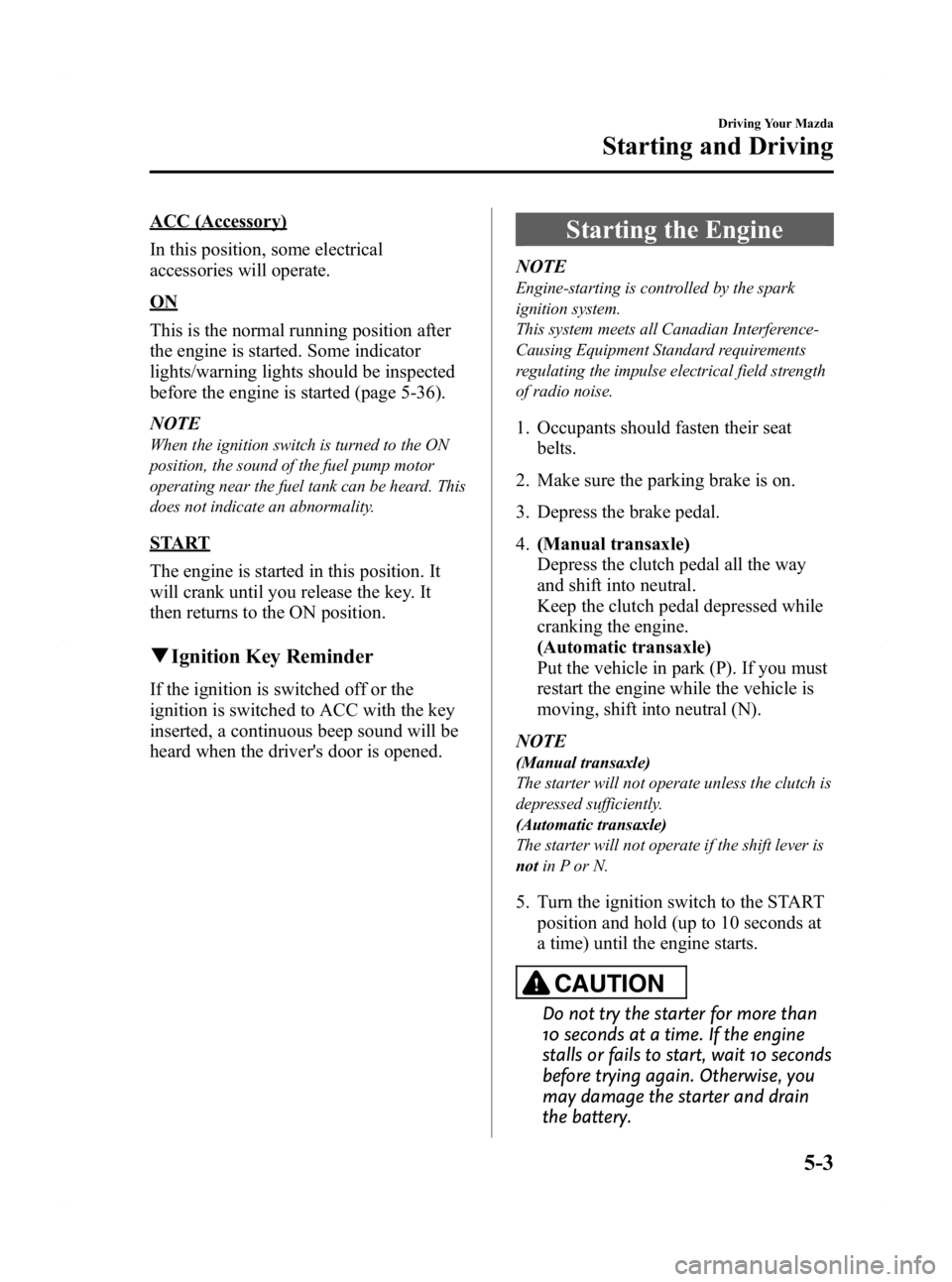
Black plate (109,1)
ACC (Accessory)
In this position, some electrical
accessories will operate.
ON
This is the normal running position after
the engine is started. Some indicator
lights/warning lights should be inspected
before the engine is started (page 5-36).
NOTE
When the ignition switch is turned to the ON
position, the sound of the fuel pump motor
operating near the fuel tank can be heard. This
does not indicate an abnormality.
START
The engine is started in this position. It
will crank until you release the key. It
then returns to the ON position.
qIgnition Key Reminder
If the ignition is switched off or the
ignition is switched to ACC with the key
inserted, a continuous beep sound will be
heard when the driver's door is opened.
Starting the Engine
NOTE
Engine-starting is controlled by the spark
ignition system.
This system meets all Canadian Interference-
Causing Equipment Standard requirements
regulating the impulse electrical field strength
of radio noise.
1. Occupants should fasten their seat
belts.
2. Make sure the parking brake is on.
3. Depress the brake pedal.
4. (Manual transaxle)
Depress the clutch pedal all the way
and shift into neutral.
Keep the clutch pedal depressed while
cranking the engine.
(Automatic transaxle)
Put the vehicle in park (P). If you must
restart the engine while the vehicle is
moving, shift into neutral (N).
NOTE
(Manual transaxle)
The starter will not operate unless the clutch is
depressed sufficiently.
(Automatic transaxle)
The starter will not operate if the shift lever is
not in P or N.
5. Turn the ignition switch to the START
position and hold (up to 10 seconds at
a time) until the engine starts.
CAUTION
Do not try the starter for more than
10 seconds at a time. If the engine
stalls or fails to start, wait 10 seconds
before trying again. Otherwise, you
may damage the starter and drain
the battery.
Driving Your Mazda
Starting and Driving
5-3
Mazda2_8BX2-EA-10K_Edition2 Page109
Thursday, December 23 2010 4:48 PM
Form No.8BX2-EA-10K
Page 111 of 340

Black plate (111,1)
Brake System
qFoot Brake
Your Mazda has power-assisted brakes
that adjust automatically through normal
use.
Should power-assist fail, you can stop by
applying greater force than normal to the
brake pedal. But the distance required to
stop will be greater than usual.
WARNING
Do not coast with the engine stalled or
turned off, find a safe place to stop:
Coasting with the engine stalled or
turned off is dangerous. Braking will
require more effort, and the brake's
power-assist could be depleted if you
pump the brake. This will cause
longer stopping distances or even an
accident.
Shift to a lower gear when going down
steep hills: Driving with your foot continuously
on the brake pedal or steadily
applying the brakes for long
distances is dangerous. This causes
overheated brakes, resulting in
longer stopping distances or even
total brake failure. This could cause
loss of vehicle control and a serious
accident. Avoid continuous
application of the brakes.
Dry off brakes that have become wet
by driving slowly, releasing the
accelerator pedal and lightly applying
the brakes several times until the brake
performance returns to normal: Driving with wet brakes is
dangerous. Increased stopping
distance or the vehicle pulling to one
side when braking could result in a
serious accident. Light braking will
indicate whether the brakes have
been affected.
Driving Your Mazda
Starting and Driving
5-5
Mazda2_8BX2-EA-10K_Edition2 Page111
Thursday, December 23 2010 4:48 PM
Form No.8BX2-EA-10K